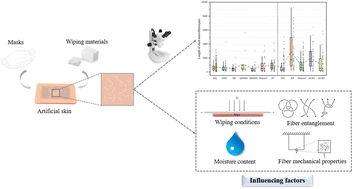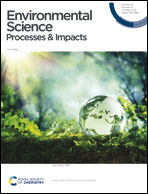Wiping conditions and fabric properties influenced the microfiber shedding from non-woven products†
Abstract
Disposable wipes and masks have come to be considered as underestimated sources of microfiber generation since the emergence of COVID-19. However, research into the creation of microfibers due to wiping with these non-woven products is scarce, and the potential effects of fabric properties on shedding behavior are unclear. This study investigated microfiber release from 7 wet wipes, 5 dry wipes, and 4 masks in response to the use of simulated daily wiping conditions on artificial skin. The dry wipes (77–568 p per sheet) shed more microfibers than the wet ones (21–190 p per sheet) after 2, 10, or 50 wiping cycles under a 9.8 N wiping force. In addition, an average of 56 microfibers could be released from per gram of wipe, and each square centimeter of wipe could release about 1.18 microfibers during wiping. Masks shed fewer microfibers than wipes due to the excellent shedding resistance of spunbond nonwoven fabrics and the strengthened mechanical properties granted by bonding points. Cellulose, polyethylene terephthalate (PET), and polypropylene (PP) were the major polymers in the microfibers shed by wipes, and the microfibers from masks were all PP. With regard to the influencing factors, the number of microfibers shed from wipes was positively associated with the number of wiping cycles (r = 0.983 and 0.960, p < 0.01) and wiping force (r = 0.980, p < 0.05), while it was negatively correlated with the moisture content (r = −0.992, p < 0.01). Interestingly, a stronger fiber entanglement degree in the wipes significantly improved the resistance to microfiber generation (r = −0.664, p < 0.05). The results highlighted for the first time that the bending coefficient (β = −5.05; 95% CI: −7.71, −2.40; p = 0.002) and fiber extraction force (β = −0.077; 95% CI: −0.123, −0.030; p = 0.005) significantly reduced the tendency for microfiber shedding. Although the number of microfibers shed from wiping was lower than those from domestic washing, there is still an urgent need to control the microfiber shedding tendencies of non-woven products through improving the manufacturing processes.

- This article is part of the themed collections: Contaminant remediation and fate and Environmental Science – coronavirus research


 Please wait while we load your content...
Please wait while we load your content...